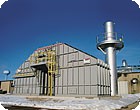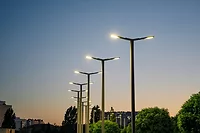When More Business is Not Good For Business

When Phillips Plastics Corporation (PPC) experienced a significant increase in its precision coatings business, production staff geared up for the increased throughput, but the environmental impact would put the company on course to exceed its EPA operating permit for the discharge of VOCs. With the company nearly over its permit limits it had to act quickly, so an internal group was formed to explore the various control technologies currently available on the market.
PPC is a world-class injection molder with leading-edge secondary decorating and assembly capabilities. The privately owned company is solely based in Wisconsin and has almost 1,600 employees spread across 15 separate locations operating in seven communities. Its 11 manufacturing facilities provide products to the medical, automotive, telecommunication and consumer product industries. The Medford, WI, facility performs plastic injection molding and provides the organization with secondary decorating operations such as painting, laser etching, laser marking, pad printing and assembly of automotive, telecommunication and consumer products.
Through the 1990s this facility ran successfully with a minor source air pollution control operation permit. This permit consists of very specific requirements to meet the Environmental Protection Agency’s (EPA) LACT (Latest Available Control Technology) regulation. These included restricted limits on VOC per gallon of paint, catalyst, thinner and cleaning solvent as purchased. This limited the types of paints and colors the company could offer customers, but given the customer needs and production volume at the time, this was a manageable situation.
Increasing Capability vs. Reducing VOC
Over the years of growing business and requests by customers for more exotic forms of paint and colors, PPC realized the need to increase its paint capabilities in order to compete. In December 2000 the company applied for two new permits with The Department of Natural Resources (DNR), one for an air pollution construction permit to install a new, state-of-the-art robotic paint line system and the other for the ability to paint small metal parts. This permit modification changed the facility from a minor source of less than 100 tons/year of VOC emissions to a major source with the potential to emit over 225 total tons.
With the new permit, PPC not only had to meet the LACT requirements for the painting of plastic parts but now also needed to meet the MACT (Maximum Achievable Control Technology) requirements for the painting of small metal parts. The MACT requirements added a higher level of restrictions to VOCs per gallon of paint as applied to metal parts. These restrictions were applicable and once again manageable.
Although the new permit allowed them to meet additional painting volume capacity requirements, PPC observed continued demand by its customers for paints that could not be used under the air permit. Additionally, with the acceptance into the ISO 14001:1996 standards, they realized the need to significantly reduce their VOC emissions.
The only way to meet the customer demands and reduce emissions was to install pollution control equipment. An internal group was formed to explore the various control technologies currently available on the market. Consideration was given to equipment/concepts such as:
- Catalytic Oxidizers;
- Thermal Oxidizers;
- Regenerative Thermal/Catalytic Oxidizers;
- Rotor Concentrator Coupled with an Oxidizer;
- Microwave VOC Reduction Technologies;
- Biofilter VOC Reduction Technologies.
After thoroughly evaluating several suppliers, PPC decided to go back to the Department of Natural Resources and request a new air pollution control construction permit to install an Anguil Model 400/40,000 SCFM (62,800 NM3/hr) Regenerative Thermal Oxidizer (RTO) for its existing paint operations.
Regenerative Thermal Oxidizer
The oxidizer would achieve destruction through the process of high-temperature thermal oxidation, converting the VOCs to carbon dioxide and water vapor while reusing released thermal energy to reduce operating costs. Process gases with VOC contaminants enter the oxidizer through an inlet manifold. Flow-control valves direct this gas into energy-recovery chambers where the process gas is preheated, then progressively heated in the ceramic beds as they move toward the combustion chamber.
The VOCs are oxidized in the combustion chamber, releasing thermal energy in the structured ceramic media beds that are in the outlet flow direction from the combustion chamber. These outlet beds are heated and the gas is cooled so that the outlet gas temperature is only slightly higher than the process inlet temperature. Fast-acting vertical poppet valves alternate the airflow direction into the ceramic beds to maximize energy recovery within the oxidizer. The VOC oxidation and high-energy recovery within these oxidizers reduces the auxiliary fuel requirement and saves operating cost. For example, at 95% thermal energy recovery, the outlet temperature may be only 70 °F (40 °C) higher than the inlet process gas temperature with an RTO. The oxidizer can reach self-sustaining operation with no auxiliary fuel usage at low concentrations.
Allen Bradley Programmable Logic Controllers (PLCs) would be used to control the automatic operation of the oxidizer from startup to shutdown so minimal operator interface is required. These controls also provide for remote telemetry to enable the system’s operation to be viewed and altered via a modem connection to reduce maintenance costs.
Later that fall the permit was accepted by the DNR for an air pollution control construction permit to install the RTO. Anguil was able to complete the design, fabrication, delivery, installation and startup of the equipment so it could go on line early the next year.
Result – A Growing Business
After startup of the new RTO, a stack test measured 99% destruction rate efficiency for VOC emissions at 100% capture. This equated to a net reduction of 58 tons of emissions in the first six months of operation. The benefits of installing the RTO included the ability to offer PPC customers a large variety of paints and colors to meet their more unique paint finish requests. Also, the RTO allowed Phillips Plastics Corporation to use previously restricted thinners and paints to better process its products with fewer rejects. This allowed the business to grow and succeed in an increasingly competitive environment and meet the new demands from customers while significantly reducing the amount of air pollution released into the environment.
For more information see www.anguil.com or contact Jeff Kudronowicz at 414/365.6400, or e-mail jeff.Kudronowicz@anguil.com.
This paper was presented at the 10th Annual Coatings for Plastics Symposium, June 2007, Chicago, IL.
Looking for a reprint of this article?
From high-res PDFs to custom plaques, order your copy today!






